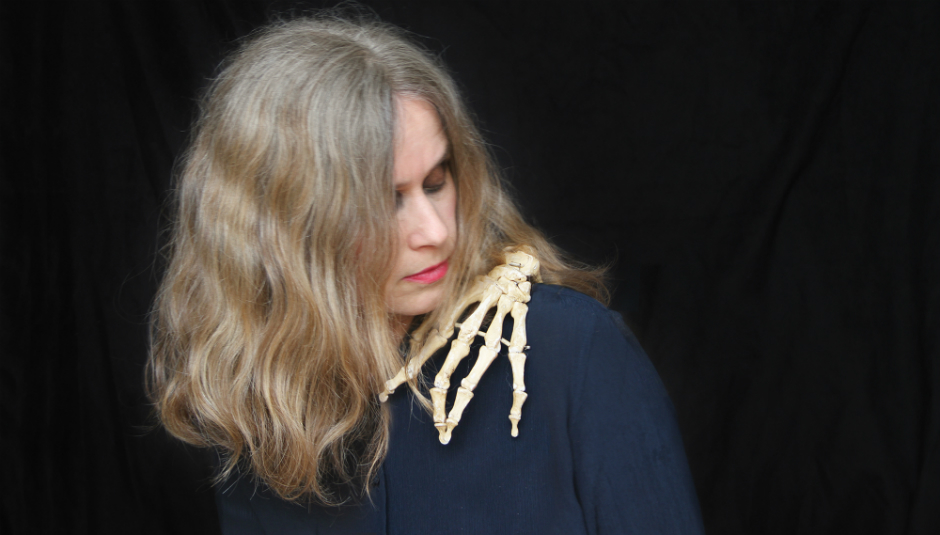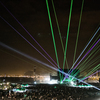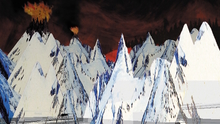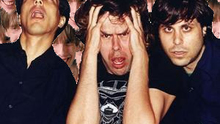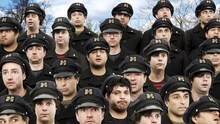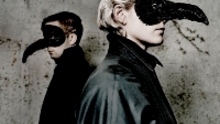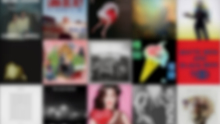Shapes and lines, lines and shapes. Whenever other writers asked aural auteur Juana Molina about the methods behind her utterly bewitching broadcasts, she gave them images she couldn’t describe, movements that she couldn’t predict. But (I told myself) serendipity alone couldn’t have guided Molina through her 20-year arc as a musician, a sublime flight path that’s taken her from the most beloved comedy show in Argentina to prime festival slots all over the world. Mind, Halo also took me to Kandinsky-like shape-scapes, geometric planes where theory and whimsy jive with each other at perpendicular angles. Yet surely another muse beyond gut instinct sang in Molina’s ear? Or were these rare forms truly conjured from the ether by her arsenal of keyboards and guitars?
Turns out my 40-minute chat with the Buenos Aires-based maestro confirmed and rebuked my suspicions. Sure, she’s had fortuitous encounters with both objects and people – and, as she tells everyone, “it’s really a collaboration of the instruments – it doesn’t come from only myself.” But Molina’s also driven by diligence. When I admit that I had no cheat sheet for her Spanish lyrics, she bristles up and sends an email to her PR rep immediately, as she and a writer pal translated everything themselves. “We put very hard work into that,” she said, ”because I feel like sometimes journalists or critics don’t really have a final opinion on the records I’ve made before because of the lyrics missing. So maybe they are afraid to say, ‘Oh, this record is really great,’ and then find out that the lyrics are really shit. It’s a fair enough fear to have.“ Of course, the lyrics aren’t shit – but I can only say that now, with a text file of incandescent poetry at my fingertips, elegant proof of the meticulous work ethos that defines Molina’s music.
At the time of this conversation, Molina is camped in Madrid, awaiting her imminent date at Barcelona’s Sónar Festival. This sparks some small talk about festivals in general, and those tricky time crunches that vex any detail-oriented artist (most of the “technical problems” that arise in a festival gig, she says, really stem from “time you didn’t have to get the proper sound”). But then I dive in with my thesis – and from there, Molina leads me into an odyssey of hard work and happenstance, where strange silhouettes offer new worlds, memories of Yes whisper from childhood, and dream guitars reveal themselves with a single note. And while luck and instinct do guide our protagonist, I’m convinced that Molina can enchant us because she’s got the patience to decipher the spell – and the good grace to share that journey with earthbound oafs like me.
DiS: So, when I was listening to Halo – I know you’ve said before that you create mostly from experimentation, but other artists pop up in my mind sometimes. What influences do you think might be working under your experiments?
Juana Molina: I think the influences that I’ve got are mostly from my childhood, where that was the period of time – childhood and teenager-hood, if you could say it that way – where I was listening all the time to new music. But when I started recording my own, I stopped listening to almost everything – I don’t listen to much music at all. I think there’s something in the air that’s common to a few of us who make the same thing. I don’t know what it reminds you of, but I’m curious, just so I could know if I’ve heard of them or not!
Well – sometimes, especially on ‘Cara De Espejo’, I’m reminded of 70s prog rock, especially Yes – which is not contemporary at all!
Oh! You know, I heard that music when I was 10 or 12. I know that music well, particularly certain albums like Relayer and Fragile. But they are records that I was listening to, that was definitely happening back then.
I thought you were going to mention something more from now.
Well, also a lot of Stereolab – I bet you get that comparison a lot – and Laetitia Sadier.
Actually, not that much. Maybe. I don’t think we are alike. Maybe we have the same approach, although the position of the songs are really different, the face of the song. I wouldn’t really relate to them – maybe the background has something in common, though.
Huh. I’m just incredibly impressed that you can draw these things out of what seems like thin air. I think it’s an incredible talent.
Well, you may be influenced by just about anything. Maybe sometimes an ad on the radio triggers something that you were not aware of. It’s hard to tell what has been going through me, and what has triggered something in me, to have a response. Because I think influences are kind of a dialogue between whatever is influencing you, and you. So it’s hard to tell.
But in any case – Yes was a good thing, because I really listened to that as a kid.
In many of your former interviews, no one ever really asks you about lyrics. Does that ever frustrate you?
Not really. I grew up listening to music that I couldn’t understand a word to, and I enjoyed very much the music, that took me on many different trips and having many soundscapes without getting a word of what they’re saying. So if what I do is able to do the same to people who don’t understand Spanish – to me, that’s good enough.
But anyway, it frustrates me that you didn’t get the lyrics! Because we put very hard work into that, with a friend of mine who’s a writer, and both of us translated the lyrics. Because I feel like sometimes journalists or critics don’t really have a final opinion on the records I’ve made before because the lyrics are missing. So maybe they are afraid to say, “Oh, this record is really great,” and then find out that the lyrics are really shit. It’s a fair enough fear to have. That’s why we worked so hard to translate as close as we could, although I didn’t want to translate everything literally. I just wanted to make sense of the lyrics, and it took us a long time to do that. So I’m going to ask Greg to send you that immediately.
Yes, I also construct soundscapes in my head when I’m listening to things, but like ‘Cálculos y Oráculos’, which has that weird sound that sounds like someone’s blowing down a glass bottle?
Ah, yes. That’s a very old sound that I have on my keyboard that I programmed maybe 20 years ago, but I’d never used it in any song. Finally, it was queuing for it to play, and there it was.
How do you figure out where a sound goes in a particular song – especially on this album, where you have a whole studio to work with?
Well, I’d been working on the album at home for two years, and then we went to the studio, and – the particular songs that don’t sound like anything else, those come from this keyboard I’m talking about, the one I’ve been playing since ’97. It’s not that I look for a sound, it’s rather the opposite – sometimes I have a song, and then I have the feeling that it needs something else, [so] I just go through what I have, and if nothing works, then I create a new sound for it to fill. It’s hard to explain with words, because rather than a feeling or a view – well, yes, [it’s] an abstract view that sound gives me. Maybe I have the feeling that it needs something bubbly, or sometimes I go through sounds that I’ve already programmed, then I hit one and I’m like, “Ah! This could work.” And if it’s not exactly what it is, then I start programming a new sound from that. And sometimes, I’m just playing around, and a sound offers me an idea of a song. It’s really a collaboration of the instruments – it doesn’t come from myself only.
How did you meet and get to trust your producer, Odin [Schwartz]?
Well, there’s a bit of confusion there, because Odin is kind of a technical producer, rather than a music producer. When I started to record this album, he helped me a lot with things that I really don’t feel like dealing with at all anymore, with computers and installing new plug-ins. And he’d bring me new plug-ins that I didn’t know that were better than the ones I had, or he knew better how to work with them than mine. So he’s been helping me with all the technical parts of making the record, which is very important.
And then – because things weren’t working at home, because computers were breaking, or instruments were breaking, or I didn’t know why effects weren’t responding – there were signals everywhere, signs for me to go somewhere else. And he insisted so much in going out to a studio, which I really didn’t want to do. So Eduardo Bergallo, the other guy we were working with on the album, he proposed going to this studio in Texas that had this very large offer of instruments that I could play with for as long as I want to unless they were taken by someone else. But I thought I was not going to be as unlucky. So we got there, and chose among a few keyboards. And I really fell in love with the [Moog] Prodigy, which was a keyboard from the 70s. I had played with something very similar in Segundo, but I wasn’t able to find something like that, or I never really looked into finding something like that; in Argentina, it’s very hard to find old, vintage instruments. And for different reasons, I don’t have that kind of keyboard, which is monophonic. So we recorded most of the basses with that kind of keyboard. So the only fact of having found that guy, that keyboard, really made worth it the trip to Texas. It really was an important instrument in the record.
I also found another one, that was a bit more complex, but it had monophonic analog sound. So all the extra sounds on ‘Cálculos y oráculos’ come from that instrument. So, as you see, the fact of finding new friends to play with…because every new instrument gives you new ideas. I think you can play any instrument, even if you don’t really know how to play it, and it will give you at least one nice thing for your songs.
So I’d been recording for two years, and then I went to the studio with Odin and Eduardo, and Diego [Lopez de Arcaute] the drummer, and the four of us recorded with a few guests, like John Dietrich of Deerhoof. He was almost a neighbor, he was only 300 miles from the studio, so that was about as close as he could get. And he spent a few days with us – he came up with some ideas. I sent him a few things so he could prepare something. And then I came back home with this huge amount of stuff that we’d been recording and started on the process of working on my own again, but with all these offers that I had from the others from the past three weeks.
I can tell, from how you talk about synths, that you’ve been enthusiastic about keyboards for a long time. How did you get into electronic sound?
When I recorded my first album, it didn’t have any keyboards, just two guitars, bass, drums, vocals. I was at one of my first gigs ever, and I saw, in the back of the room, a very strange silhouette. I got totally distracted, because I didn’t know if it was someone that was totally into the music, or if it was someone with some mental problems…it was the way he was moving. It wasn’t normal. It wasn’t what you were used to seeing. And I honestly forgot my lyrics, because I was so into this shape that I was looking at. He was in the middle of the corridor, so I have his silhouette, there was a light just on him and only him. And I couldn’t really gauge where that shape came from. And then he approached me after the show was over, and this shape took a different form – he turned out to be a person. He was totally bald, and he had this huge beard, and he was fat, and very smiley, with this smile that I’ll never forget. And then he said, “I think I have some songs you may like!” And I think he was friends with the drummer, so he was someone I could trust, he wasn’t someone who would rape me in my house.
So he came. And I see this big guy coming with a keyboard in his hands, and I’m like, “Oh, no, oh no no, this is going to be some horrible 80s experience.” Then I was freaking out, that I was going to spend the most horrible afternoon. Surprisingly, he started playing me things – and I’m like, “But where are all these amazing sounds coming from?” Honestly, I was expecting something totally different. I was expecting something cheap, and thin – and it was the opposite, it was rich and thick, and full of music.
So he came that afternoon, and he left three months later. He kind of stayed at home for three months, and we couldn’t stop playing. He was the one that introduced me to the synthesizer world. It was amazing. It was the best thing that could’ve happened to me, that someone brought me such a different idea. Even though I grew up listening to Yes, and other prog rock bands, I didn’t – what do you call it, when you separate something in parts, like a person or an animal?
Mmmm…dissect!
Yes. I wasn’t dissecting the bands as I was listening to them. It was a whole thing. As a kid, I wasn’t listening and going, “Oh, nice guitar! Oh, nice bass!” So I didn’t even think about the possibility of playing with keyboards. I didn’t ever ask myself what that was. So I never figured out that I could go to my own roots with those keyboards. And it took me a few years, because of this guy, who got me into this amazing addicting world.
Yeah – that is how you think as a kid, though. I remember listening to Yes for the first time, and that Close To The Edge record and all those beautiful organ solos, and I bet those were all keyboards, and I didn’t know. [Actually, that IS a real organ – but Rick Wakeman also played bunches of other keyboards, so ‘twas a fair guess.]
Yeah, exactly. I don’t know. But yeah, it’s so good when that still happens. It’s rare when that happens now, that I get a new band or some new music, and I get it as a whole thing, which is how it should be: just music, where there aren’t any instruments, there aren’t any musicians, it’s just the final result. And that’s, to me, the most important thing, to just build something that’s just SOMETHING, with its own personality. And instruments are just that – instruments to get to the final result, which is the music.
Some people go on about the particular gear that does it for them – I take it that’s not your approach?
Well, at the same time, I’ll have to admit, that [with] all the guitars I’ve bought (which aren’t many) by choosing them, the same thing happened. One was with a Martin, an acoustic guitar that I found at Gibson Guitars, but it’s totally out of my possibilities to buy it. I just couldn’t. I couldn’t buy that guitar. It was out of my range. That was it. So I kept looking for another guitar in that same shop, and I found one. It was expensive, but I could pay it. And I was queuing, and thankfully there were six people before. And the guitar that I couldn’t have was again hanging on its thing on the wall, on my left. And I felt something, and I just looked, and I saw it hanging there. And I was approaching the cashier, and just kept looking at it. And when I was about to pay for the new guitar, I just said, “Can I try that once again?” And the person was like, “Yeah, sure.” So I tried it – and I looked at my boyfriend, and he said, “You know what, if you have to buy it, just buy it.” And it was such a difference. And then I composed most of the songs for my records with that guitar.
There is something particular with the guitars, with instruments. I’m not saying you could play the same thing with any instrument. There are some guitars that can give you some kinds of songs, and there are some guitars that can give you other types of songs.
Another day, I was just looking for a nylon guitar, and then I played one that they had offered me. And I was like, “Yeah, OK.” But then – you know when they hang them, one on top of the other, in a row, so that you only see the side of it? And I saw some kind of wood, so I was like, “What about that one?” And he was like, “Oh, that’s a very cheap, nice, German guitar.” So I played it, and I played just one note – and this happened in each of the three instances I’m going to tell you about – I played just one note, just one string, and that was it. I knew that was the guitar.
So there was the Martin, the German one, and then the last guitar I bought. When I turned into electric – I decided that because someone had lent me a guitar for a tour six years ago. I had my Martin, but we were so many on stage, that it was difficult to have enough volume with an acoustic guitar and me, and everyone else’s volume. So I asked if I could have an electric guitar, just to be able to play and be heard. And someone lent me an amazing ’63 Stratocaster by Fender, and I said, “I’m not going to stop until I find a guitar exactly like this one.” I was in New York, which is one of the most amazing places to find instruments, and I had a week to find myself a guitar. And I didn’t find that one, but I found this SG – and I played just this one note, and something happened. Even though it was a bit heavy, I could not leave it. I had to buy it. So there is something, about the instruments.
What I wouldn’t do is tour with a hundred guitars. That, I think, is going too far away. Too much. What would I do, just play one song with [each]?
Speaking of time, that reminds me – it took you about four years to get from Un Dia to Wed 21 – and now, it’s taken you about four years to get from Wed 21 to this one. You’ve previously cited a lack of inspiration – were you having the same problems here?
I wouldn’t necessarily call it a problem, to be honest. It’s just the natural time that these things take – for me. It depends on the way you tour – if I toured on a bus, and I could build a studio in the back of the bus (which I wouldn’t think is possible, because they’re always very noisy) – but I don’t know. If I’m travelling, and touring, and sleeping in a different hotel every night, I am so far away from composing. And if you’re touring for two years, those are two years where you don’t even approach the idea of composing a song.
And now that I’m carrying an electric guitar, it’s even less the case. With an acoustic guitar, you can play it in your room, and maybe record it on a phone, so you don’t forget the idea. But with an electric guitar, it’s not very tempting. And then I work a lot through inertia: if I’m working, then I want to just keep working. If I’m making an album, I have the feeling that I could make three albums, or four. I could never stop playing and creating things. But then, when I stop, it’s very hard to restart.
But who says how long do you need to make a new album? What’s the normal time period? I think that’s something from a commercial point of view, that it should be two years at the most. But I don’t agree that that’s an issue.
So what are your next moves, after this tour?
Well, as soon as I get home, I have to finish the music for a short from a Japanese couple, called Opotura. They made a video for me, in exchange for me doing the music for their video. So it’s going to be an 8-minute thing, that I need to finish by July, and I’m very excited about it. I think it’s going to be a very good thing to do. And I have to do it, even if I don’t want to, because I need it ready for August.
And then I don’t know! We will be touring a lot until the end of the year, so I don’t think I’m going to write much stuff until next year, at least.
[I ask about the name of the short, and she starts sifting through her email to find it. As she does, she talks a bit about the couple:]
They’re very good…they create these very Japanese creatures. I really like Japanese cartoons.
Oh – like anime?
No, it’s not anime. Anime has its own characteristics. This is just a cartoon…but the story they are building is the name of two characters.
How did you meet this couple?
We met in Japan. Well – we met by email a long time ago, they dropped me a letter that [said] they wanted to make something for me, and then we finally met last year. It’s an American guy and Japanese woman. But yes, I need to look properly for it.
Oh, yeah. It’s weird trying to do two things at once.
Exactly! Because I can’t listen to you and – I’m very bad at trying to do two things at one time.
Halo is out no via Crammed Records. For more information, including forthcoming live dates, please visit her official website.

